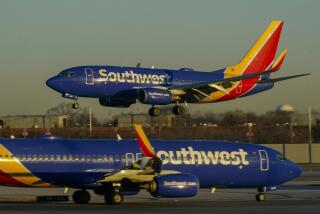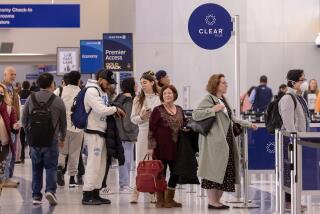Airline seat-reclining dispute is story about civility, modern air travel
- Share via
It seems there are two types of people in the world, or at least on an airplane: those who believe they have a fundamental right to recline their seat and those who cannot imagine anything worse than people who believe they have a fundamental right to recline their seat.
Recently, on United Airlines Flight 1462 from Newark to Denver, those two types clashed in spectacular fashion.
A female passenger became irate when she discovered that she couldn’t put her seat back because a man sitting behind her was employing a “Knee Defender” a $22 device that can force a seat to remain upright. When the argument escalated to the point where the woman threw a cup of water at the man after he refused to remove the device, the flight was diverted to Chicago, where the two passengers, both 48, were escorted off the plane.
It’s a story, in a sense, about two people behaving badly. But it’s also about civility, public space, and yes, modern air travel.
“Who is supposed to yield?” is a basic question in any society, said Janie Harden Fritz, a Duquesne University professor specializing in civility. “When we live in public with others, we’re going to step on each others’ toes sometimes. Part of living with others is yielding sometimes, or thinking others should yield to us.”
As for the plane, Fritz believes that if a person were to demonstrate model plane etiquette, the passenger in front should turn around and ask the passenger behind if he or she minds if the seat reclines. “Most people, if you ask, will say go ahead and lean back,” she said.
But what actually happens most of the time, said Steve Hansen, of Manchester, Pa., is that people recline their seats without asking. And for Hansen, who is 6-foot-2, it’s not a situation he’s happy with.
“I’m ashamed to admit it but I am thinking evil thoughts the whole time,” he said, of the person reclining the seat in front of him. “You’ve made this passive/aggressive choice to violate my space.”
Hansen will jam his legs into the seat in front of him “so they understand they are going into an object.” He will occasionally speak loudly about his discomfort. He believes that once upon a time, when airlines were more spacious, seat reclining may have been appropriate.
“People should understand that a reclining seat is from another era it’s like smoking on a flight,” he said. “You just don’t get to do that anymore.”
Hansen is not alone three years ago, Pulitzer Prize-winning Washington Post writer Gene Weingarten created a printable card designed to be passed to a seat recliner. “I know you meant no harm in reclining your seat,” reads the card, “but doing so takes an already disagreeable situation and makes it even more stressful for others.”
But such a view is likely one of a passionate minority. Most fliers even tall ones are probably more like Lisa Tomasovich of Franklin Park, Pa. The 5-foot-11 Tomasovich travels frequently, and admits that seat reclining used to bother her to the point where she wouldn’t recline her own seat as a matter of principle.
She’s even had moments where she’s had to speak to people to plead for mercy. “I felt like I was holding their body weight up with my knees,” she said.
But these days, she accepts that people recline their seats and she reclines her own. “I’m not bothered by it as much,” said said. “I understand that it’s a part of travel.”
For Nat Hunter, of Hampton, Pa., it’s a matter of perspective. Hunter is 6-foot-8, and will certainly do everything in his power to be seated in an exit row with more leg room. If that fails, and someone in front of him reclines a seat, he will sometimes stand up and loom over them, so the passenger can see his height.
But it’s not something he gets worked up about. “I just jam myself in there, or sit in an aisle and have one leg out,” he said. “If you get very upset about every little indignity that comes your way, then when the big one comes along it’s like the boy who cried wolf.”
For the 6-foot-8 Wesley Lyons, a motivational speaker and former Pittsburgh Steeler who lives in Homestead, Pa., it’s an issue he just tries to avoid entirely. He generally refuses to fly any airline except Southwest, where he’ll politely ask to preboard so that he can sit in the front row. On a recent trip where he ended up in regular seating, he asked a woman in an exit row if he could switch, even offering her money to do so (she switched for free).
Flying is so uncomfortable that the Knee Defender, which is technically allowed by the Federal Aviation Administration but banned by major airlines, is something he’d consider. “It’s a little deceitful,” he said, “but at the same time you want to make sure you can get to your destination without being in too much pain.”
Hansen believes it’s an issue created by the airlines and one he believes the airlines can help solve. The pre-flight announcements should include a message instructing passengers to speak to the person sitting behind them. “They should force the person who is actually reclining to have to confront the other person, but they don’t do that at all,” he said. “There is no protocol so that of course becomes the problem.”
(c)2014 Pittsburgh Post-Gazette
Visit the Pittsburgh Post-Gazette at https://www.post-gazette.com
Distributed by MCT Information Services
More to Read
Sign up for The Wild
We’ll help you find the best places to hike, bike and run, as well as the perfect silent spots for meditation and yoga.
You may occasionally receive promotional content from the Los Angeles Times.






